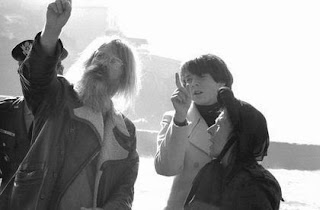
Hal Ashby, who would have turned 80 last September, enjoyed a brief but exhilarating directing career. The former editor (an Oscar winner for 1967's "In the Heat of the Night") helmed eleven narrative films, plus one documentary, in a span of about 15 years.
His debut, 1970's fabulous "The Landlord," was something of a happy accident. Norman Jewison had commissioned Kristen Hunter's novel to direct himself, but pre-production work on "Fiddler on the Roof" sidelined him and he generously handed the material to Ashby, his house editor.
A year later came the seminal "Harold and Maude" which, like "The Landlord," was not immediately embraced by critics or audiences.
This was Ashby's Act One as a budding auteur.
His Act Two was something of a jaw-dropper - rich, beautifully realized films starting with "The Last Detail" in 1973 and continuing with an almost breathlessness with "Shampoo," "Bound for Glory," "Coming Home" and "Being There." Much of what is written these days about Ashby revovles around these titles.

Ashby with Bud Cort and Ruth Gordon onAshby's Act Three, however, produced during a particularly troubling time in his private life, is no less interesting. His choice of material was as personal and idiosyncratic as ever and his eye for casting remained fresh and sure. Less sure was his directorial confidence but the shared erratic quality of his final four films only make them more fascinating.
"Harold and Maude," perhaps his signature film
Either by accident or perhaps on purpose, Ashby's work on "Second-Hand Hearts" (1981), "Lookin' to Get Out" (1982), "The Slugger's Wife" (1985) and "Eight Million Ways to Die" (1986) mirrored much of the expressionism that John Cassavetes was specializing in at the time.
"Second-Hand Hearts" (aka, "The Hamster of Happiness"), a shaggy-dog tale about losers, offers the singular team of Robert Blake and Barbara Harris, who are compulsively watchable here. "Second-Hand Hearts", a lost title, may be genuine Cinema Obscura, but "Lookin' to Get Out" recently made it to DVD in a narratively enhanced version that restores footage excised by Paramount. Ashby managed to take a buddy gambling film here and somehow twist it into something vaguely existential.
More mainstream and middlebrow, "The Slugger's Wife," an original screenplay by Neil Simon, comes with an unexpected melancholy with Michael O'Keefe and Rebecca DeMornay, fine performers who never hit the big time, as two people - a ballplayer and a singer not entirely made for each other. The film lingers almost in spite of itself.
Martin Ritt puts in a bit as the wittily named Burly DeVito, manager of the Atlanta Braves, the team for which O'Keefe slugs.
Much more memorable but no less erratic is "Eight Million Ways to Die," an atmospherically sordid character study with Jeff Bridges outstanding as detective who uses booze to self-destruct, seesawing between his planned rehabilitation and the vices that permate his personal/professional lives. Rosanna Arquette and Alexandra Paul are the atypical female leads here.
Ashby's documentary was The Rolling Stones' "Let's Spend the Night Together" (1983). Trailing off towards the end, he directed Neil Young in something called "Solo Trans" (1984); the pilot of Dennis Franz' TV series, ""Beverly Hills Buntz" (1987) and his last, "Jake's Journey," a 1988 British TV film with Graham Chapman and Peter Cook.
He died in in December of that year of liver and colon cancer.
No comments:
Post a Comment